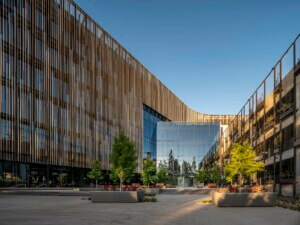On the heels of its tenth anniversary, downtown San Francisco’s controversial Millennium Tower may soon turn things around. After it was announced in 2016 that the 645-foot-tall tower had sunk 17 inches into the ground and tilted 18 inches west, the city threatened to block access to the building until a swift and cost-efficient solution was found. Last year, the city announced a $100 million solution to retroactively construct proper bedrock-supported piles to stabilize the residential tower.
According to the San Francisco Chronicle, that plan was endorsed late last month by a four-person panel hired by the city, after deliberating that they “[saw] no reason to withhold approval of the building permit.” The structural engineering firm Simpson Gumpertz & Heger proposed that the building’s original structural system, a “10-foot-thick concrete foundation bonded by nearly 1000 reinforced concrete piles driven close to 90 feet into a layer of soft clay,” could safely be replaced by a set of piles long enough to reach the bedrock underneath.
At 250 feet tall, two feet wide, and over 140,000 pounds each, the 52 new steel-and-concrete piles will provide significantly more structural stability than their predecessors. Simpson Gumptertz & Heger concluded that the improvements will not come quickly; it’s estimated that each pile will take “three to four days to drill into place,” and the process would be made more difficult with the addition of a “reinforced concrete inner pile installed within each steel shaft.” However, when considering the city’s history of catastrophic earthquakes, the revised structural plan will no doubt serve to put its residents and neighbors at ease.
The San Francisco Department of Building Inspection warned that if plans were not made to improve the structural conditions of Millennium Tower, the building could sink and tilt at an exponential rate, while adding that it could “increase forces and deformations on the foundation, which may in the future trigger mandatory repair provisions of the San Francisco existing building code.”
The solution will likely set a precedent for other towers being built in the area and elsewhere. Niall McCarthy, an attorney representing a group of homeowners, told the Guardian that “this litigation exposed a lot of problems in the development of this particular building,” and that “it will be a roadmap for other downtown developments for what to avoid.” Though its original structural system—dropping piles into soft, loamy soil instead of attaching it to bedrock—is fairly common in the city, it should have been anticipated that Millennium Tower’s significant weight and height would have necessitated more substantial footing.











